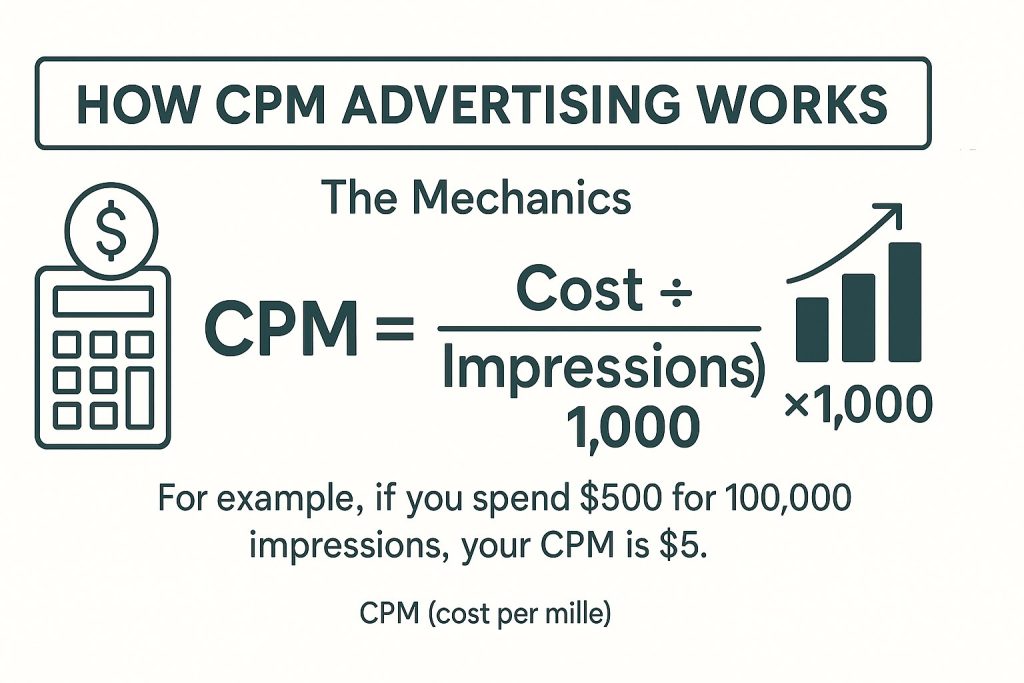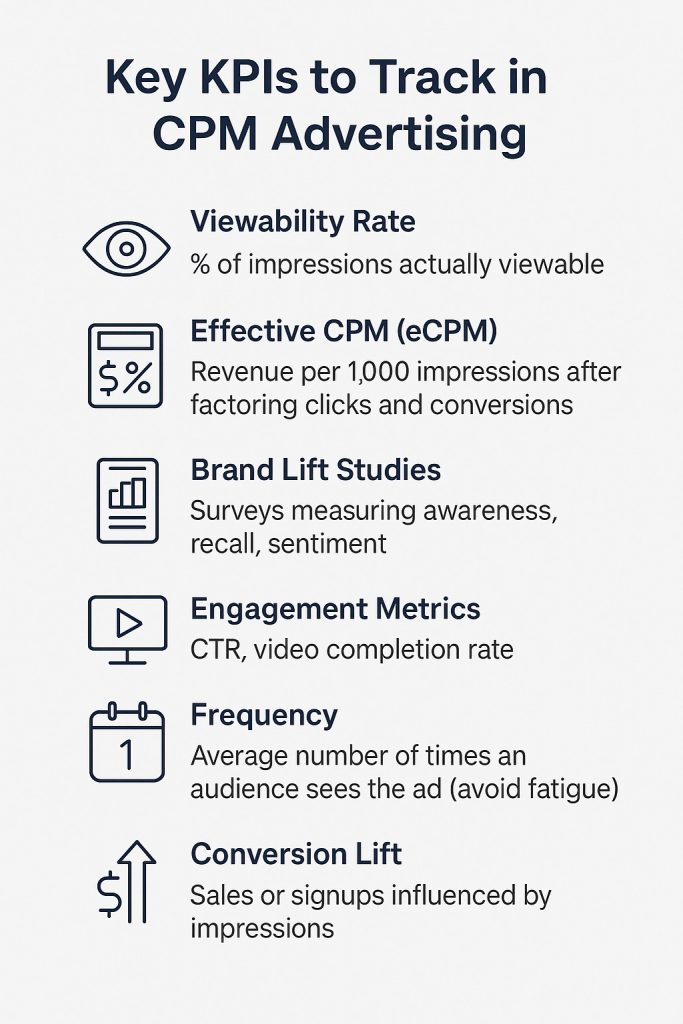Have you ever wondered why some brands seem to be everywhere you look on your social feed, in your favorite podcast, on a banner during tonight’s game while others fade quietly into the background? It’s not just luck or bigger budgets; it’s often about how wisely they use Cost Per Mille (CPM) advertising.
Imagine this: you launch a new product and need millions of people to see it, fast. You don’t just want clicks yet you want visibility, awareness, and recognition. That’s when CPM becomes your strategic ally. At its core, it’s the simple idea of paying for every 1,000 impressions, but in reality, it’s much more a way to engineer brand presence at scale.
In 2025, CPM isn’t just an old-school pricing model. With programmatic media buying, AI-driven targeting, and contextual placements replacing cookie-based ads, CPM has evolved into one of the most powerful awareness-building tools in modern marketing. To maximize its impact, brands often combine CPM with affordable PR strategies, creating a stronger blend of visibility, credibility, and cost efficiency.
What is Cost Per Mille Advertising?
Definition and Core Concept
Cost Per Mille (CPM) advertising is a digital ad pricing model where advertisers pay a fixed amount for every 1,000 impressions of their ad. “Mille” comes from the Latin word for thousand. Unlike Cost Per Click (CPC) or Cost Per Acquisition (CPA), CPM focuses on visibility rather than direct engagement.
This makes CPM particularly effective for brand awareness campaigns, top-of-funnel strategies, and industries where impressions build equity over time (such as luxury, consumer packaged goods, and entertainment).
The Strategic Role of CPM
In 2025, impressions aren’t just numbers, they’re signals of attention in an attention-scarce economy. Strategists use CPM to:
- Enter new markets cost-effectively.
- Build reach quickly before a launch.
- Control brand presence across premium placements.
How CPM Advertising Works
The Mechanics
The formula is simple:
CPM = (Cost ÷ Impressions) × 1,000
For example, if you spend $500 for 100,000 impressions, your CPM is $5.

But behind the scenes, programmatic ad exchanges run real-time auctions, where algorithms match your ad with audiences across devices and channels. CPM rates vary based on:
- Audience demographics
- Channel (social, display, video, audio)
- Placement quality (premium publisher vs open web)
- Seasonality (holiday campaigns cost more)
Practical Example
A fashion brand launching a summer line may buy 2 million impressions on Instagram at a $7 CPM. That’s a $14,000 spend designed to saturate feeds during peak shopping weeks, ensuring awareness before conversion campaigns kick in.
Benefits of CPM Advertising
Broad Reach at Scale
With CPM, you can put your message in front of millions of eyeballs quickly, making it ideal for awareness campaigns.
Cost Predictability
Unlike CPC or CPA models, CPM offers budget clarity—you know exactly what 1,000 impressions will cost, making forecasting easier.
Strong Fit for Awareness Goals
When the objective is exposure rather than clicks, CPM aligns perfectly. For example, entertainment brands use CPM to promote movie trailers or album launches where visibility matters most.
Premium Placements
High CPM rates often unlock exclusive inventory, think front-page takeovers, prime-time video slots, or Spotify premium ads.
Challenges of CPM Advertising
Viewability vs Visibility
Not every “impression” is truly seen. Ads below the fold or ignored due to “banner blindness” reduce actual impact.
Low Direct ROI Measurement
Since CPM focuses on impressions, it’s harder to link spend to conversions directly. Attribution models are required to measure true value.
Ad Fraud Risks
Bots and invalid traffic can inflate impressions, wasting spend. Fraudulent publishers still plague the ecosystem.
Rising Costs in Premium Markets
As competition intensifies, CPM rates climb—especially on video and connected TV platforms. Without optimization, CPM can become expensive.
Modern Trends in CPM Advertising (2025)
The advertising world in 2025 looks very different from just a few years ago. Cost Per Mille (CPM) has moved far beyond simple impression-buying and evolved into a data-driven, AI-powered, and privacy-conscious ecosystem. Marketers are no longer satisfied with cheap reach they’re chasing quality impressions that build brand equity, drive engagement, and align with customer values. From the dominance of programmatic buying to the rise of Connected TV and even sustainability metrics, CPM is adapting to new expectations in both technology and society. Below are the key trends shaping how strategists use CPM today.
1. Programmatic Buying Dominance
Over 90% of digital display ads in 2025 are bought programmatically. Algorithms optimize CPM in real time, ensuring better targeting and fewer wasted impressions.
2. AI-Driven Targeting
AI predicts which segments will deliver not just impressions, but high-value impressions. For example, AI identifies micro-moments when users are most receptive to ads.
3. Contextual + Privacy-First Targeting
With cookie deprecation, contextual CPM placements are rising—matching ads to content relevance, not personal data.
4. Video and CTV Boom
CPM rates on Connected TV (CTV) and premium video inventory continue to climb, as audiences shift from cable to streaming.
5. Sustainability Metrics
Advertisers now evaluate CPM campaigns not only on impressions but also on carbon footprint per impression, pushing ad tech toward green practices.
Key KPIs to Track in CPM Advertising
Even though CPM is impression-based, strategists measure beyond cost:
- Viewability Rate → % of impressions actually viewable.
- Effective CPM (eCPM) → Revenue per 1,000 impressions after factoring clicks and conversions.
- Brand Lift Studies → Surveys measuring awareness, recall, sentiment.
- Engagement Metrics → CTR, video completion rate.
- Frequency → Average number of times an audience sees the ad (avoid fatigue).
- Conversion Lift → Sales or signups influenced by impressions.

The Bottom Line: CPM as a Strategic Lever
Cost Per Mille (CPM) advertising is not a relic of the past — in 2025, it’s a cornerstone strategy for brand architects. But its power lies not in indiscriminate reach, but in intentional reach. When you combine CPM with AI-driven targeting, contextual placement, and precision measurement, it graduates from a simple cost model to a growth multiplier.
Savvy marketers don’t obsess over the lowest CPM; they pursue the most valuable CPM — the impressions that influence perception, drive interest, and foster loyalty. Every 1,000 impressions becomes an opportunity to shape your narrative, move minds, and prime users for deeper engagement.
As new innovations reshape digital campaigns, aligning CPM strategies with insights from Digital Marketing Trends ensures your brand keeps pace with modern consumer behavior. And to sharpen your daily learning curve, Best Blogs to Read Daily for Marketers offers practical resources to keep strategies fresh and competitive.
So the real question for marketing leaders isn’t “Should I run CPM campaigns?” It’s “How do I weave CPM into a media system that balances awareness, engagement, and conversion?” Master that synergy, and CPM will sustain your brand’s visibility, credibility, and competitive edge well into the future.


